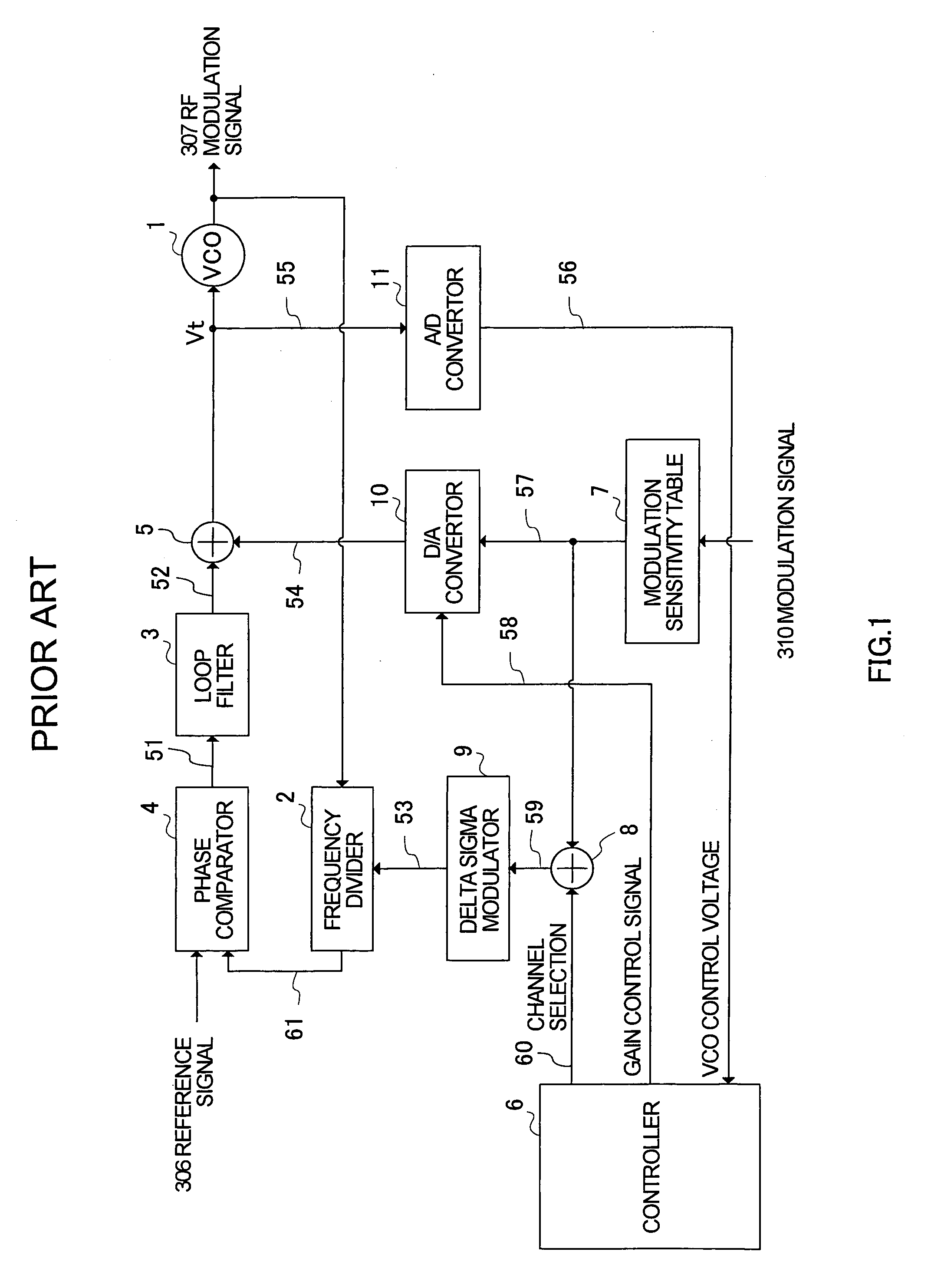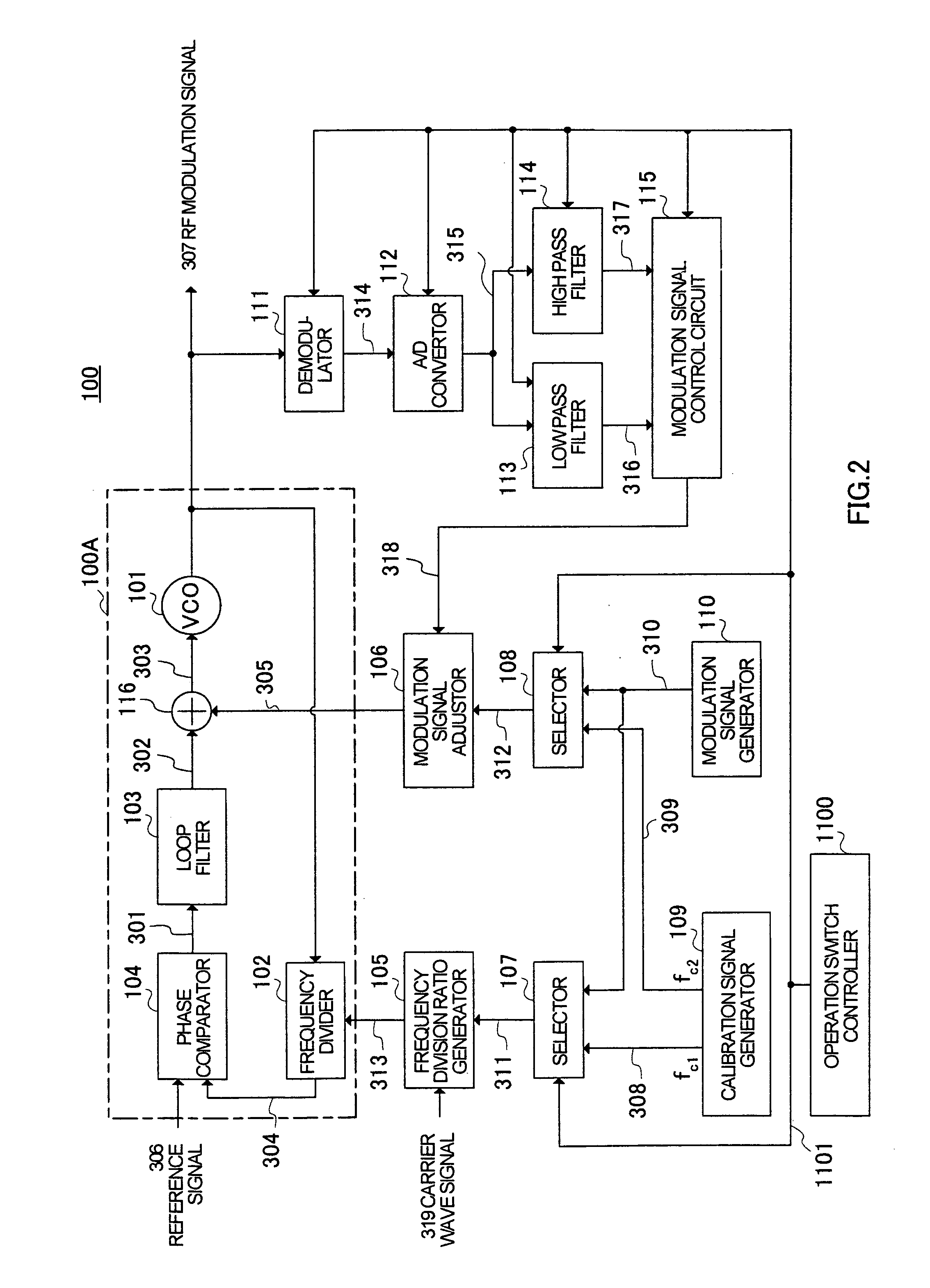PLL modulation circuit and polar modulation apparatus
a modulation circuit and polar modulation technology, applied in modulation, pulse technique, digital transmission, etc., can solve the problems of deterioration in modulation accuracy, deterioration in noise characteristics, etc., and achieve the effect of improving modulation accuracy
- Summary
- Abstract
- Description
- Claims
- Application Information
AI Technical Summary
Benefits of technology
Problems solved by technology
Method used
Image
Examples
embodiment 1
(Embodiment 1)
[0034]FIG. 2 shows a simplified configuration of a PLL modulation circuit according to Embodiment 1 of the present invention. As shown in FIG. 2, PLL modulation circuit 100 according to Embodiment 1 of the present invention has PLL section 100A, which includes voltage controlled oscillator (VCO) 101, frequency divider 102, phase comparator 104, loop filter 103 and adder 116. VCO 101 changes the oscillation frequency in accordance with the voltage inputted in the control voltage terminal. Frequency divider 102 divides the frequency of RF modulation signal 307 outputted from VCO 101. Phase comparator 104 compares the phase of output signal 304 of frequency divider 102 and the phase of reference signal 306 and outputs a signal in accordance with the phase difference between the two signals. Loop filter 103 outputs signal 302, which is an equalized version of output signal 301 of phase comparator 104. Adder 116 adds the value of signal 302 from loop filter 103 and the valu...
embodiment 2
(Embodiment 2)
[0054]FIG. 11 is a block diagram showing the configuration of a polar modulation apparatus according to Embodiment 2 of the present invention. Parts in Embodiment 2 of the present invention that are identical to ones in Embodiment 1 will be assigned the same reference numerals as in Embodiment 1 without further explanations.
[0055]As shown in FIG. 11, polar modulation apparatus 200 according to Embodiment 2 of the present invention has PLL modulation circuit 100 of Embodiment 1 of the present invention, and, in addition, non-linear power amplifier201 and amplitude modulation signal generator 202.
[0056]RF modulation signal 307 from VCO 101 of PLL modulation circuit 100 is inputted in non-linear power amplifier 201 as a phase modulation signal. Amplitude modulation signal generator 202 generates amplitude modulation signal 2021 ad sends it to non-linear power amplifier 201 as a control signal. In accordance with the voltage value of amplitude modulation signal 2021, non-l...
embodiment 3
(Embodiment 3)
[0059]FIG. 12 is a block diagram showing the configuration of a wireless communication apparatus according to Embodiment 3 of the present invention. Parts in Embodiment 3 of the present invention that are identical to ones in Embodiment 2 will be assigned the same reference numerals without further explanations.
[0060]As shown in FIG. 12, wireless communication apparatus 400 according to Embodiment 3 of the present invention has PLL modulation circuit 100, non-linear power amplifier 201, and amplitude modulation signal generator 202 in polar modulation apparatus 200 of Embodiment 2 of the present invention, and, in addition, transmission and reception switch 401, antenna 402, and receiver 403. Transmission and reception switch 401 switches between supplying transmission signals from PLL modulation circuit 100 of polar modulation apparatus to antenna 402 and supplying received signals from antenna 402 to receiver 403. Non-linear power amplifier 201 sends output transmiss...
PUM
 Login to View More
Login to View More Abstract
Description
Claims
Application Information
 Login to View More
Login to View More - R&D
- Intellectual Property
- Life Sciences
- Materials
- Tech Scout
- Unparalleled Data Quality
- Higher Quality Content
- 60% Fewer Hallucinations
Browse by: Latest US Patents, China's latest patents, Technical Efficacy Thesaurus, Application Domain, Technology Topic, Popular Technical Reports.
© 2025 PatSnap. All rights reserved.Legal|Privacy policy|Modern Slavery Act Transparency Statement|Sitemap|About US| Contact US: help@patsnap.com



